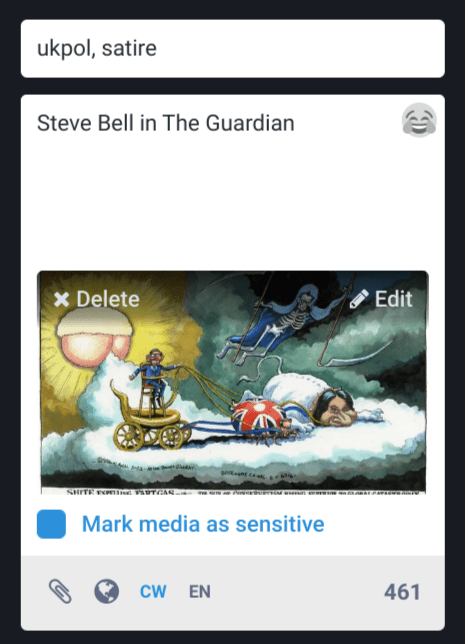One of the things that has surprised me most about people migrating from Twitter to Fediverse platforms such as Mastodon has been people’s confusion over the ‘favourite’ button. It’s a star symbol and, as with in the earlier days of Twitter, it has no real function other than to the person pressing the button and the person who’s post is being favourited.
On Twitter, of course, the ‘like’ button (which morphed into a heart over time) had an algorithmic function; other people began to be shown posts that were liked, but not necessarily retweeted, by others in their network. Or by influential people. Or because its content was likely to provoke a reaction in you. Or maybe… something else? Who knows, the algorithms involved are proprietary.
In The Social Dilemma, there’s a powerful scene where a representation of a teenage boy is being created by the data he willingly hands to Big Tech companies. The algorithms are anthropomorphised in a way that helps less technical people understand what’s going on. While some of us may smile and comment on how it doesn’t really happen like that (algorithms don’t have intentions, as such) it’s nevertheless a good way of driving home the message that human flourishing is often at odds with shareholder value. Your ‘engagement’ with a platform might leave you angry for hours, days, or weeks just for a small increase in share price.
Meanwhile, on most Fediverse platforms, including Mastodon, there are essentially four ways of interacting with other people’s posts:
- Reply
- Boost
- Favourite
- Bookmark
There’s no ‘quote tweet’-like functionality on Mastodon, which is a purposeful attempt to stop sealioning. That’s why full-text search isn’t available, either.
These are all technical things, whereas what makes the Fediverse the Fediverse is the culture that’s been created over the last half-decade. As Clive Thompson writes:
Perhaps even more important than the design of Mastodon is the behavior established by its existing user base — i.e. the folks who’ve been using it for the last six years. Those people have established what is, in many ways, an antiviral culture. They push back at features and behaviors that are promoting virality, and they embrace things that add friction to the experience. They prefer slowness to speediness.
[…]
This is in part because Mastodon’s earliest communities included many subaltern groups who wanted to avoid the dogpiling harassment they’d received on major social networks — and understood that well-engineered friction would help.
What’s interesting to me is the culture clash between the way that the technology and culture works/worked on Twitter, and how it is in the Fediverse. It’s like the way that the former works is the ‘default’ in some way, and then that framing views how the Fediverse is seen.
I get it. I think I first wrote about being on Mastodon in… 2017? But you can’t look at something that is new to you and think about what it lacks compared to what you’ve grown accustomed. Not everything involves faster horses.
What I’m hoping that people are discovering is the peace of mind in not being encouraged by an opaque algorithm to make declarative statements in the hope for more engagement and virality. There’s something a lot more human, a lot more calming and convivial, about pressing a button and having a human on the other side.


